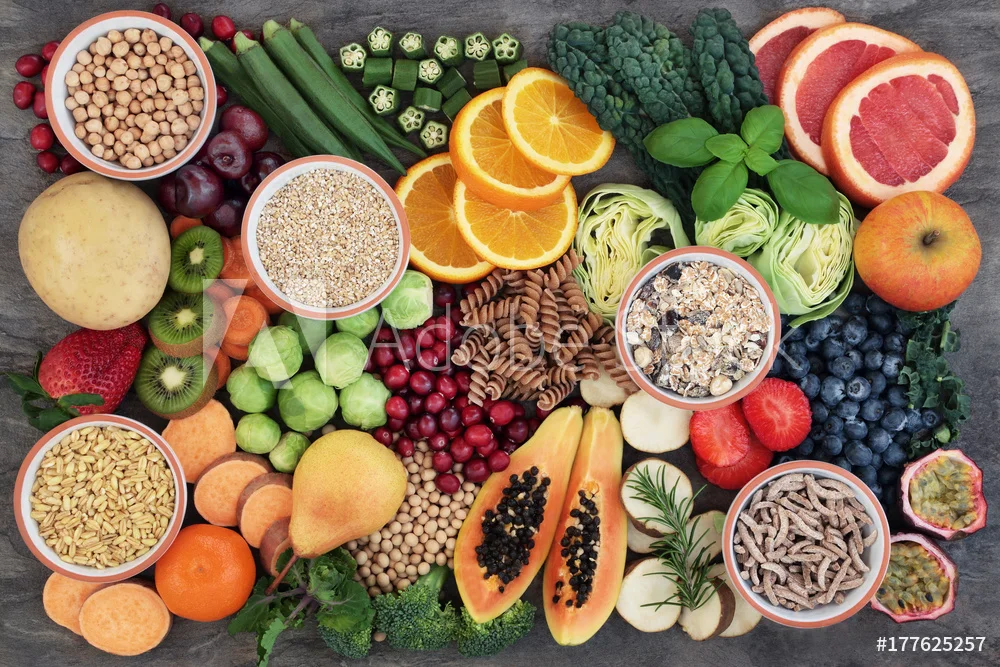fibre
What is fibre?
Fibre is an indigestible form of carbohydrate found in foods of plant origin. There are two main types of fibre – soluble and insoluble. All plants contain some of both kinds of fibre, some however have more soluble and some have more insoluble.
Soluble: Cellulose, hemicellulose, psyllium (non-fermented) , beta-glucans, gums, pectin (soluble fibre) are Found in and around plant cells, prebiotic, soluble in water forming a viscous gel. It is readily fermented in the colon into gases and physiologically active by-product’s.
Insoluble: Lignins (insoluble fibre) found in the plant structure, doesn’t act as a prebiotic, metabolically inert, it does not absorb water as it moves through the digestive system, speeding up and easing defecation.
Fibre acts by changing the nature of the contents of the gastrointestinal tract and by changing how other nutrients and chemicals are absorbed. Soluble fibre absorbs water to become a gelatinous, viscous substance and is fermented by bacteria in the digestive tract. Insoluble fibre has a bulking action and is not fermented.
Chemically, dietary fibre consists of non-starch polysaccharides such as arabinoxylans, cellulose, and many other plant components such as resistant dextrins, inulin, lignin, waxes, chitins, pectins, beta-glucans, and oligosaccharides. A mixture of different fibres in different ratios are found in different pants.
Food sources of dietary fibre are often divided according to whether they provide (predominantly) soluble or insoluble fibre. Plant foods contain both types of fibre in varying degrees, according to the plant's characteristics.
Why do we need soluble fibre?
Soluble fibre helps to remove hardened faecal matter from the lining of the colon wall. Soluble fiber binds to bile acids in the small intestine, making them less likely to enter the body, this in turn lowers cholesterol (including the bad LDL) levels in the blood. Soluble fiber also attenuates the absorption of sugar, reducing the sugar response after eating, which can prevent fat storage, and reduce the risk of insulin resistance and diabetes. Fibre binds to fatty acids, normalising blood lipid levels. They act as prebiotics and are fermented in the colon by bacteria, producing short-chain fatty acids as byproducts producing wide-ranging physiological activities. Short chain fatty acids are a major energy source for colonocytes (cells of the colon) and they produce an acid environment preventing growth of harmful bacteria and yeasts. Healthy functioning colonocytes will also reduce the risk of inflammation in the gut linked to many digestive issues.
Insoluble fibre is mainly found in wheat bran, other whole grains and some vegetable and fruit skins.
Why do we need insoluble fibre?
Insoluble fibre helps keep the bowels regular. Consuming insoluble fibre also produces healthful compounds during its fermentation, and insoluble fibre's ability via its passive hygroscopic properties (the ability of a substance to attract and hold water molecules from the surrounding environment through either absorption or adsorption with the absorbing or adsorbing material becoming physically changed, by an increase in volume, stickiness, or other physical characteristic of the material as water molecules become 'suspended' between the material's molecules in the process) increase bulk, soften stool, and shorten transit time through the intestinal tract.
Soluble fibre is mainly found in legumes, vegetables, fruits, oats, barley, rye and seeds.
Can you have too much fibre?
Yes! Disadvantages of a diet high in fibre are the potential for significant intestinal gas production and bloating and elimination of important nutrients. Constipation can occur if insufficient fluid is consumed with a high-fibre diet. Constipation also results in the re-absorption of toxins.
Functions of fibre in the body
It improves transit time and assists the movement of waste products through the gut. Fibre acts like a broom and sweeps waste material along the digestive tract, thus preventing the build up of stale faeces in the colon, which can lead to toxins being released which irritate the digestive tract.
It helps balance the levels of glucose by binding to the sugar molecules and slowing down their absorption into the blood.
It helps stabilise blood cholesterol and therefore reduces the risk of heart disease.
It helps to protect against haemorrhoids, varicose veins, diverticular disease, gallstones, kidney disease and constipation.
It helps reduce the build up of toxins, yeasts and unfriendly bacteria.
It binds to and deactivates carcinogens therefore helping reduce the risk of colon cancer.
Conditions fibre can help improve
| Crohn's Disease | Haemorrhoids | Irritable Bowel Syndrome |
| Constipation | Hiatus Hernia | Kidney Disease |
| Diverticular Disease | High Blood Pressure | Ulcers |
| Gallstones | High Cholesterol | Varicose Veins |
| Some Cancers |
Sources of fibre
| Almonds | Brown Rice | Oats |
| Apples | Brussels | Peaches |
| Apricots | Sprouts | Pears |
| Asparagus | Cabbage | Peas |
| Bananas | Carrots | Potatoes |
| Barley | Celery | Prunes |
| Beetroot | Courgette | Pulses |
| Beans | Figs | Raisins |
| Berries | Lentils | Rye |
| Broccoli | Nuts | Seeds |
| Spinach | Sweet Potato |
Top tips for incorporating fibre in your diet
Always drink plenty of water and fluids as this helps your body to use fibre safely
Increase your fibre intake gradually over several weeks. If you increase your fibre intake too quickly you may experience gas and bloating
Avoid coarse wheat bran as this can be irritating to the digestive system. Instead go for more soluble fibre as found in oats, beans, brown rice, pulses, fruit and vegetables.
To get more fibre from potatoes eat them with the skins if they are organic (if they are not organic it's best to peel them)
Eat at least 3 pieces of fresh fruit a day
Eat at least 3 different vegetables with your meals during the day
Snack on nuts, seeds and dried fruit as these all contain fibre
Flaxseeds/linseeds are an excellent source of fibre and if soaked in water before eating are easily digested and gentle on the digestive system
Oat bran is a finer ground form of oats and is gentler on the digestive system. It can be made into a smooth porridge to which seeds and/or fresh fruit can be added
Ideally you should be eating at least 35g of fibre a day. If you make sure that 2/3 of your meals contain fruit, vegetables or grains then you will be getting sufficient fibre
Amounts of fibre in everyday foods
| Fruit | Amount | Fibre (grams) |
| Apples with skin | 1 medium | 5 |
| Apricots, fresh | 3 medium | 0.98 |
| Apricots, dried | 5 pieces | 2.89 |
| Banana | 1 medium | 3.92 |
| Blueberies | 1 cup | 4.18 |
| Cantaloupe, cubes | 1 cup | 1.28 |
| Figs, dried | 2 medium | 3.74 |
| Grapefruit | Half medium | 6.12 |
| Orange, navel | 1 medium | 3.40 |
| Peach | 1 medium | 2 |
| Peaches, dried | 3 pieces | 3.18 |
| Pear | 1 medium | 5.08 |
| Plum | 1 medium | 1 |
| Raisins | 1.5 oz box | 1.6 |
| Raspberries | 1 cup | 8.34 |
| Strawberries | 1 cup | 3.98 |
| Vegetables | ||
| Avocado | 1 medium | 11.84 |
| Beets, cooked | 1 cup | 2.85 |
| Beet greens | 1 cup | 4.20 |
| Bok choy, cooked | 1 cup | 2.76 |
| Broccoli, cooked | 1 cup | 4.5 |
| Brussel sprouts | 1 cup | 2.84 |
| Cabbage, cooked | 1 cup | 4.20 |
| Carrot | 1 medium | 2 |
| Carrot, cooked | 1 cup | 5.22 |
| Caulifower, cooked | 1 cup | 3.43 |
| Celery | 1 stalk | 1.02 |
| Coleslaw | 1 cup | 4 |
| Collard greens, cooked | 1 cup | 2.58 |
| Courgette, cooked | 1 cup | 2.63 |
| Green beans | 1 cup | 3.95 |
| Kale, cooked | 1 cup | 7.20 |
| Onions, raw | 1 cup | 2.88 |
| Peas, cooked | 1 cup | 8.84 |
| Peppers, sweet | 1 cup | 2.62 |
| Popcorn, air popped | 3 cups | 3.60 |
| Potato, baked with skin | 1 medium | 4.80 |
| Spinach, cooked | 1 cup | 4.32 |
| Summer Squash, cooked | 1 cup | 2.52 |
| Sweetcorn | 1 cup | 4.66 |
| Sweet potato, cooked | 1 cup | 5.94 |
| Swiss chard, cooked | 1 cup | 3.68 |
| Tomato | 1 medium | 1 |
| Winter Squash | 1 cup | 5.74 |
| Cereal, grains, pasta | ||
| Bran cereal | 1 cup | 19.94 |
| Bread, wholewheat | 1 slice | 2 |
| Oats, rolled dry | 1 cup | 12 |
| Pasta, wholewheat | 1 cup | 6.34 |
| Rice, dry brown | 1 cup | 7.98 |
| Beans, nuts, seeds | ||
| Almonds | 1 oz | 4.22 |
| Black beans, cooked | 1 cup | 14.92 |
| Cashews | 1 oz | 1 |
| Flax seeds | 3 tbsp | 6.97 |
| Kidney beans, cooked | 1 cup | 13.33 |
| Lentils, red cooked | 1 cup | 15.64 |
| Lima beans, cooked | 1 cup | 13.16 |
| Peanuts | 1 oz | 2.30 |
| Pistachio nuts | 1 oz | 3.10 |
| Pumpkin seeds | 1/4 cup | 4.12 |
| Soybeans, cooked | 1 cup | 7.62 |
| Sunflower seeds | 1/4 cup | 3 |
| Walnuts | 1 oz | 3.08 |


